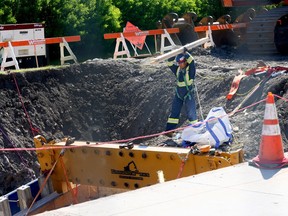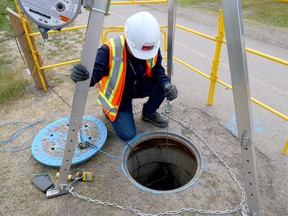Montreal suffers water main break similar to Calgary’s. Who’s next?
‘Failure is always associated with lack in maintenance operations due to underestimating the condition of the pipe’
Article content
When it comes to the catastrophic failure of critical water infrastructure, Calgary suddenly has company.
Advertisement 2
Article content
Residents of Montreal were treated to a visual spectacle Friday when a large water main burst east of downtown, creating a geyser of water more than two storeys in the air.
Some of the particulars of the incident will sound familiar to Calgarians.
The water main break happened without warning to a pipe that was installed less than 40 years ago, meaning it was less than halfway through it expected lifespan.
While it’s too soon to say why and how the break occurred, officials have speculated the affected pipe could have suffered corrosion due to the infiltration of winter road salt.
Repairs are expected to take many weeks, owing to the absence of the necessary parts and equipment to fix the issue.
The huge pipe — more than two metres wide — is the main conduit for treated water destined for homes and businesses in the eastern part of Montreal.
Article content
Advertisement 3
Article content
Those parts of the city were briefly placed under a boil-water advisory as a precaution.
This is where the stories diverge significantly.

Water network redundancy prevents rationing
While it’s expected to take a month to repair the broken water main and the pulverized section of road and sidewalk above it, Montrealers are not being asked to ration their water use until necessary fixes are complete.
The reason: there is a parallel feeder main connecting water treatment plants to various reservoirs servicing the affected areas, a Montreal water official told local media.
As we all now know, this is something Calgary doesn’t have — at least not yet.
The Bearspaw South feeder main had the misfortune of rupturing before any backups had been built.
Advertisement 4
Article content
A city official said in a briefing on August 9 that additional feeder mains fanning out from the Bearspaw treatment plant in the northwest were in the process of being planned and designed when Calgary suffered its water emergency on June 5, crippling the giant pipe that usually moves 60 per cent of the city’s drinking water.
The timeline for these additional water mains has since been moved up, said Michael Thompson, Calgary’s general manager responsible for infrastructure.
It’s alarming that yet another Canadian city joins Calgary in having had no idea something as critical as a feeder main was damaged to the point of suffering a catastrophic failure.
How many more watery time bombs are lurking under this nation’s streets?
Advertisement 5
Article content

Broken water mains leave trail of woes across continent
While Calgary Mayor Jyoti Gondek and others have used this city’s water emergency as a rallying cry for more funding to renew aging infrastructure, neither the Bearspaw South feeder main (installed in 1975) nor the water main that exploded in Montreal last week (installed in 1985) was old enough to have needed replacing.
The particular vintage of pipe used in the Bearspaw South feeder main — called prestressed concrete cylindrical pipe or PCCP — appears prone to premature aging and sudden failure, according to news articles recounting previous catastrophic water main breaks in North America, including one incident in southern California in 1999, four incidents in Florida since 1979 and nine incidents in Maryland since 1996.
Advertisement 6
Article content
Meanwhile, a paper by the National Research Council presented to Western Canada Water’s annual conference in Regina in September 2008 stressed the importance of vigilance for water system operators.
“PCCP failure is often catastrophic because it occurs with no leak that can serve as an alarm by being visually detected at the surface, and would allow for rapid intervention to repair the pipe and therefore prevent the failure,” wrote Riad Al Wardany, an NRC research officer.
“PCCP failure is always associated with lack in maintenance operations due to underestimating the condition of the pipe and thus its priority to be repaired.”
Yes, higher orders of government need to step up with infrastructure money for cities, but local governments also need a better regime for gauging the health of critical water pipes so repairs can be made before they fail — and fail the people they are meant to serve.
Recommended from Editorial
Article content



